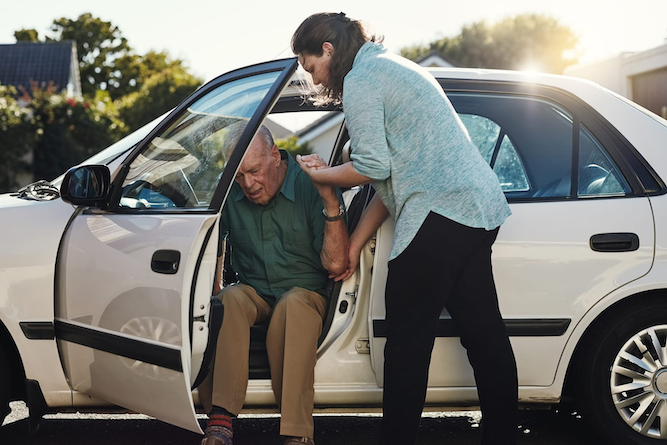
As people age, it’s natural for their driving abilities to deteriorate. And because driving is a source of significant independence, seniors, and their loved ones, often find themselves at a frustrating crossroads. Thankfully, seniors can prolong their freedom and retain their ability to drive for several more years if they exercise certain precautions.
In this exploration of safe driving tips for seniors, we’ll discuss practical ways older adults can safely and effectively use their motor vehicles, even as their senses and responsiveness diminish.
We’ll cover the following:
Recognizing and adapting to age-related changes
As you age, your senses, such as hearing and vision, naturally begin to diminish. However, each person is unique, meaning the rate at which your vision and hearing become less acute will vary. Contrary to popular belief, many individuals can continue driving safely well into their 60s and 70s.
Most people experience a gradual decrease in visual acuity and hearing capabilities. Since these changes happen gradually, you may not even realize your vision or hearing is getting worse.
Because these changes are often unapparent, it’s important to schedule regular, comprehensive driving evaluations. During these evaluations, a licensed professional will assess your senses and confirm that you’re able to drive safely.
Another consideration is your reaction time and reflexes.
According to the American Physiological Society Journal, the average person’s response time for simple tasks decreases by two to six milliseconds per decade. Researchers found greater reaction time differences between healthy, young people and older adults when handling complex tasks such as driving.
Driving skills become less sharp as you age. If you want to drive safely after your reaction times have increased, you’ll need to implement new driving habits, such as:
- Eliminating distractions (turning your music down, putting your phone away, etc.)
- Giving yourself more time to stop
- Ensuring that you’re well-rested
- Taking breaks when you’re fatigued
Putting your phone away and paying attention are universal safe driving practices, but adhering to these strategies is even more important for older drivers.
Key safe driving tips for seniors
Optimizing traffic safety for seniors begins with the right tools. Power steering and a high-quality, ergonomic steering wheel are natural features that make driving much safer for seniors than in the past. So, the first step in safe driving for seniors is making sure that your vehicle is in good working order and that all safety features are functional.
You can also enhance these features in various ways, such as by installing a wheel cover to help you maintain a firm, stable grip on the wheel. This is especially important if you suffer from arthritis or weakness in your hands.
Of particular note is the fact that newer cars come with numerous safety features that can help seniors stay a little safer. However, don’t feel like you have to buy a new car to maintain your independence. If it’s not possible to make a new purchase, you can get a lot of mileage out of keeping your car in tip-top shape and using its existing safety features.

If you decide to shop for a new vehicle, look for advanced safety features like lane departure assist, a backup camera with a large viewing screen, and a collision alarm. These features can lead to cheaper car insurance premiums and minimize the risk of unsafe driving.
With those preliminary considerations out of the way, let’s explore some more safe driving tips for seniors.
What are the four safe driving tips?
There are a few basic principles you should follow to make yourself a safer, more capable driver, no matter your age or capabilities:
1. Stay physically active
Regular physical activity promotes strength and mobility, which can help you control the steering wheel, look over your shoulder to change lanes, and make other quick and precise movements while driving.
If you’ve suffered a major medical event that impacts your driving ability, see a certified driving rehabilitation specialist. They’ll provide targeted exercises and drills to help you regain your driving abilities. You might also consider taking a defensive driving course to brush up on your skills.
Whether you’re rehabbing after an incident or taking a proactive approach to staying fit and healthy, the key is to find healthy activities you like doing.
When possible, prioritize social or group activities. According to Harvard Health Publishing, broader social interaction provides a wide range of mental and physical health benefits, including helping older adults stay more active.
Think about it this way: would you rather hit the gym alone or play a game of pickleball with your friends? The latter option can help you stay motivated, as others are depending on you to show up and participate.
2. Get your vision checked
Vision is critical to driving, so you should have your eyes checked annually. Corrective lenses can compensate for many vision deficits.
If your provider prescribes lenses, make sure to use them while you’re driving. You may even be legally required to wear your eyeglasses, depending on the quality of your vision and how reliant you are on your corrective lenses to see normally.
Remember, vision changes occur gradually. Don’t wait until you experience severe deterioration of your vision to get checked. If you notice small signs like difficulty reading the morning paper, schedule an appointment and get checked.
Maintaining good vision will promote driving safety. Ensuring that your depth perception is accurate is especially important. Otherwise, basic tasks like stopping in time for a red light or responding to changing roadway conditions will become exceedingly difficult.
3. Drive during daylight and good weather
Modern vehicles are loaded with safety features. However, even the most technologically advanced vehicles only provide 60% of the visibility necessary to meet optimal safety standards.
Driving at night can be dangerous, even for someone with perfect vision. So unless absolutely necessary, only drive during the day. Driving in the rain or snow can be even more difficult. So if bad weather is on the way and you don’t feel comfortable driving in it, reschedule your appointments and shift your plans as needed.
The easiest way to avoid driving in bad weather is to plan your trips, regularly check the weather report, and refrain from hitting the road in harsh conditions.
Avoiding night driving is also fairly easy. Before leaving the house, use your GPS to determine how long it will take you to reach your destination. Check how long the return trip will take, as well, and don’t forget to account for variations in traffic volume.
For instance, if you leave to visit a loved one at 10:00 a.m. and plan to return home at 5:00 p.m., be aware that the second trip will probably take longer due to commuter traffic, and leave early enough to get back home before dark.
4. Use technology
Modern vehicles are equipped with myriad technologies designed to help promote driving safety and convenience. If possible, buy a newer vehicle acclaimed for its safety and convenience features. Some driving safety features to prioritize include:
- Steering wheel radio controls
- Navigation technology
- Backup camera
- Lane departure assist
- Collision warning/prevention systems
If you have a slightly older vehicle without modern connectivity capabilities or simply want to upgrade the tech in your existing car, Motion Car Connect can help. This all-in-one platform keeps track of your vehicle’s location, documents your behavior to help you become a safer driver, and provides predictive maintenance alerts.
Enhance your driving safety with Motion Car Connect. Experience the peace of mind that comes with advanced driving assistance. Learn more about how Motion Car Connect can support your driving journey. Drive Safe With Motion.
When to consider alternative transportation
There’s no set age at which driving abilities end. That said, it’s crucial to regularly evaluate your driving skills. Be mindful of warning signs like:
- Frequent close calls
- Discovering dents or scrapes on your vehicle
- Getting lost in familiar places
- Difficulty making decisions or concentrating
When these signs become apparent, it might be time to look into alternative forms of transportation. The good news is there are numerous transportation options for seniors.
If you live in a metropolitan area, you can take advantage of public transit, such as buses and shuttles. Your area may also have community shuttles designed for seniors.
One of the most universal alternatives is ride-sharing. Services like Uber and Lyft are available nationwide, meaning you should have no problem finding someone to take you where you need to go. You can also cut down on trips by taking advantage of conveniences like grocery delivery services and online ordering.
What age do most seniors stop driving?
According to the AARP, most people stop driving when they turn 75. However, there are no hard and fast rules when it comes to driving safety. Seniors with health problems may need to give up driving sooner, while those in tip-top shape may be able to keep driving well into their late 70s.

The key is to monitor your skills and overall health. Follow your healthcare provider’s advice, and don’t ignore warning signs like frequent confusion or diminishing vision.
Enhancing driving skills and knowledge
If you want to keep driving into your 70s and beyond, you need to be proactive about enhancing health, driving skills, and knowledge — after all, practice makes perfect. With that in mind, consider the following opportunities:
Defensive driving courses for seniors
Many organizations offer driving courses tailored to senior drivers. These courses can reinforce your driving skills, teach you new techniques, and help you adapt to changes in road rules, traffic laws, and vehicle technology.
Even though you’ve been driving for decades, it never hurts to refine your skills or get a refresher on concepts you may have forgotten.
Staying informed with local and state laws
Keeping up with the latest road safety rules and vehicle technologies can make a big difference in your ability to drive safely and confidently. This includes understanding how to use advanced driver-assistance systems (ADAS) in newer cars.
Driving safely: A guide for seniors, family, and friends
If you are an older driver, first make sure that you’re keeping your vehicle in good working order and taking advantage of all safety features.
Next, avoid distractions and drive within your abilities. That means avoiding nighttime cruising and not driving during inclement weather — unless you have the reaction time and skill level required to do so. The key is to control as many variables as possible so you can make the most of your driving capabilities.
If you’re the family or friend of a senior driver, remember that your support is crucial in helping them maintain their independence while ensuring road safety. This doesn’t mean staying silent — rather, it’s important to voice your concerns without being confrontational. Encourage regular health check-ups, discuss safe driving strategies, and approach conversations about alternative transportation with empathy.
As for identifying unsafe driving habits, be on the lookout for unexplained or mysterious damage to their vehicles. If you notice any dents, dings, or scratches, ask your loved one what happened. If they don’t know or can’t remember, it may be time to explore alternative transportation options. Confusion, poor mobility, and declining vision are other concerns to be mindful of.
If your elderly loved one decides to give up their keys and let you start doing some of their driving for them, there are a few things you can do to make the experience as frictionless as possible.
First, be respectful, and remember that the transition is probably hard for them. Secondly, don’t make them feel like an inconvenience or burden. Make it clear that you’re happy to help, especially if you’re taking them to a medical appointment or other important engagement. If you make them feel like a burden, they may neglect essential care or start postponing appointments out of shame or frustration.
Technology to keep you confident on the road
Learning to leverage technology to improve your driving experience isn’t just great advice for seniors. It’s also one of the most effective tips for new drivers, highly experienced drivers, and everyone in between. Modern vehicle tech like Motion Car Connect can be especially valuable for senior drivers and their loved ones.
Motion Car Connect provides a plethora of safety, security, and convenience features.
The platform monitors driving behavior, gives driver safety scores, provides speed alerts, and sends automatic crash notifications to emergency personnel. It also offers live GPS tracking, geofencing capabilities, and disturbance alerts to safeguard your vehicle from theft.
Looking for a tool to complement or enhance your safe driving habits? Discover how Motion Car Connect features can assist you in driving safely, especially in challenging conditions. Get Started.